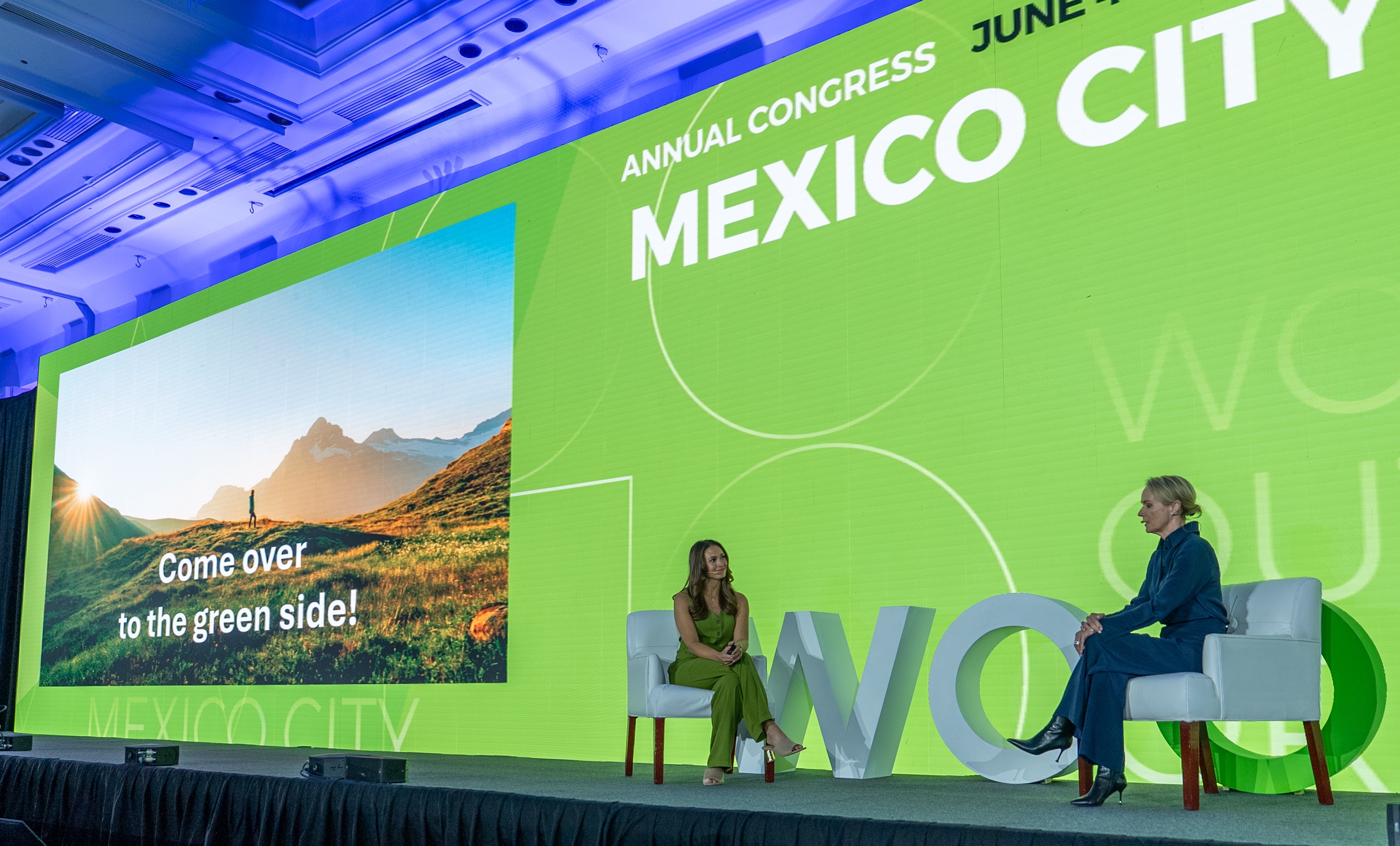
23. June 2025
blowUp and Omnicom at WOO-Congress: 'Come over to the green side!'
At the World Out of Home Organization's (WOO) Annual Congress in Mexico, industry leaders spotlight Out-of-Home (OOH) as a green media channel and highlight WOO’s support for Ad Net Zero in enhancing carbon measurement for OOH.
The World Out of Home Organization (WOO) Congress in Mexico brought together global media leaders to discuss innovation, creativity, and sustainability in Out-of-Home (OOH) advertising.
A highlight of the event was the joint keynote by Katrin Robertson, CEO, blowUP media Group (part of Ströer Group), and Stephanie Scheller, Managing Partner Sustainable Solutions EMEA, Omnicom Media Group, who issued a clear call to action: “Come over to the green side!”
Scheller emphasized that media activities, according to Ad Net Zero, can account for between under 5 and over 40 percent of a company’s total emissions – depending on the industry, number of campaigns, and media mix.* With global regulations increasingly requiring companies to calculate emissions across their entire value chain, including media, this highlights the growing responsibility of the advertising sector.
However, the lack of a unified baseline has long been a challenge: more than 30 different methodologies for calculating media emissions are currently in use. To address this, Ad Net Zero – a global industry initiative to reduce greenhouse gas emissions from advertising – launched the Global Media Sustainability Framework (GMSF) in 2024. This voluntary industry standard was developed collaboratively by stakeholders in working groups and is publicly accessible. It aims to bring greater consistency and transparency to media carbon calculation.
“The framework is a powerful example of what open collaboration and dialogue at eye level can achieve in our industry,” said Stephanie Scheller. “We’re proud to actively contribute to its development and help make practical solutions accessible to all. It takes organizations like Ad Net Zero and WOO to bring stakeholders together, challenge the status quo, and embed sustainability in our industry for the long term.”
This shared commitment to transparency and collaboration sets the stage for the next chapter: how Out-of-Home media is already delivering measurable environmental benefits.
European studies confirm that OOH emits significantly less CO₂ per 1,000 contacts than other media channels.** As a one-to-many medium, OOH is inherently efficient. The industry is constantly driving forward sustainable innovations with remarkable dynamics. In the UK, for example, 90% of the energy used in the OOH sector comes from renewable energy.*** Energy-saving technologies like LED lighting and solar power further reduce the environmental impact. Additional measures like PVC-free banners and urban greening underscore the sector’s strong commitment. Katrin Robertson showcased best practice examples from around the world, demonstrating how media owners are actively reducing emissions while creating societal value – by installing public infrastructure, enhancing urban environments, and serving communities in meaningful ways.
“OOH is one of the few media channels that combines environmental efficiency with advertising impact,” said Katrin Robertson. “What’s especially compelling is the level of innovation and green commitment we’re seeing across the industry. Media owners and companies are following clear sustainability roadmaps and are actively managing their supply chains accordingly. From smart and green energy use to green infrastructure and recycled materials, these initiatives reflect a broader transformation in how we design and evolve media in public spaces. OOH has the power to drive sustainability while making cities more resilient, inclusive, and future-ready.”
A key announcement from the Congress was WOO’s support for Ad Net Zero in refining the Global Media Sustainability Framework (GMSF) to better reflect the specific characteristics of Out-of-Home media. Originally developed by Ad Net Zero, the GMSF provides a consistent methodology for calculating greenhouse gas emissions across all major media types and is now being enhanced with WOO’s input and expertise to ensure accurate calculation across OOH formats like Classic, Transient, and Digital.
“We’re proud to be working with WOO to help bring consistency and transparency to the calculation of greenhouse gases from media,” said Anthony Falco, Global Media Sustainability Director at Ad Net Zero. “Thanks to the expertise and insights provided by the OOH sector, we are going to be able to develop channel level data guidance which reflects operational realities, essential to making the framework practical and actionable.”
This collaboration empowers brands, agencies and media owners to make unified, sustainable choices – and positions OOH as a leading channel in the green media transition.
As the media industry faces increasing regulatory pressure and growing demand for climate-conscious campaigns, WOO and its members are taking bold steps to lead the way. With the GMSF and a shared commitment to innovation, the future of media is not only measurable – it’s sustainable.
Sources:
*Ad Net Zero, Global Sustainability Framework, 2024
**FAW Fachverband Außenwerbung & bynd consulting, 2023: Return on Environment | Mediaplus & ClimatePartner, 2021: Green GRP Initiative | Outsmart UK & KPMG, 2024: Low Carbon, Low Power. An analysis of OOH energy consumption and CO2 emissions.
***Outsmart UK & PwC, 2023: Supporting UK society: The impact of the Out of Home advertising sector.


